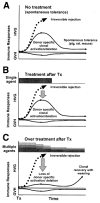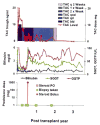The unfinished legacy of liver transplantation: emphasis on immunology
- PMID: 16447295
- PMCID: PMC3095842
- DOI: 10.1002/hep.20959
The unfinished legacy of liver transplantation: emphasis on immunology
Abstract
Liver transplantation radically changed the philosophy of hepatology practice, enriched multiple areas of basic science, and had pervasive ripple effects in law, public policy, ethics, and theology. Why organ engraftment was feasible remained enigmatic, however, until the discovery in 1992 of donor leukocyte microchimerism in long-surviving liver, and other kinds of organ recipients. Following this discovery, the leukocyte chimerism-associated mechanisms were elucidated that directly linked organ and bone marrow transplantation and eventually clarified the relationship of transplantation immunology to the immunology of infections, neoplasms, and autoimmune disorders. We describe here how the initially controversial paradigm shift mandated revisions of cherished dogmas. With the fresh insight, the reasons for numerous inexplicable phenomena of transplantation either became obvious or have become susceptible to discriminate experimental testing. The therapeutic implications of the "new immunology" in hepatology and in other medical disciplines, have only begun to be explored. Apart from immunology, physiologic investigations of liver transplantation have resulted in the discovery of growth factors (beginning with insulin) that are involved in the regulation of liver size, ultrastructure, function, and the capacity for regeneration. Such studies have partially explained functional and hormonal relationships of different abdominal organs, and ultimately they led to the cure or palliation by liver transplantation of more than 2 dozen hepatic-based inborn errors of metabolism. Liver transplantation should not be viewed as a purely technologic achievement, but rather as a searchlight whose beams have penetrated the murky mist of the past, and continue to potentially illuminate the future.
Conflict of interest statement
Potential conflict of interest: Nothing to report.
Figures








Similar articles
-
Microchimerism, dendritic cell progenitors and transplantation tolerance.Stem Cells. 1995 Nov;13(6):622-39. doi: 10.1002/stem.5530130607. Stem Cells. 1995. PMID: 8590864 Free PMC article. Review.
-
Chimerism and tolerance in transplantation.Proc Natl Acad Sci U S A. 2004 Oct 5;101 Suppl 2(Suppl 2):14607-14. doi: 10.1073/pnas.0404829101. Epub 2004 Aug 19. Proc Natl Acad Sci U S A. 2004. PMID: 15319473 Free PMC article. Review.
-
The mystique of hepatic tolerogenicity.Semin Liver Dis. 2000;20(4):497-510. doi: 10.1055/s-2000-13158. Semin Liver Dis. 2000. PMID: 11200418 Review.
-
Themes of liver transplantation.Hepatology. 2010 Jun;51(6):1869-84. doi: 10.1002/hep.23595. Hepatology. 2010. PMID: 20235333 Free PMC article. Review.
-
[Development of immune tolerance in liver transplantation].Gastroenterol Hepatol. 2011 Mar;34(3):155-69. doi: 10.1016/j.gastrohep.2010.11.007. Epub 2011 Mar 3. Gastroenterol Hepatol. 2011. PMID: 21376423 Review. Spanish.
Cited by
-
Tolerance Induction in Liver.Int J Organ Transplant Med. 2015;6(2):45-54. Int J Organ Transplant Med. 2015. PMID: 26082828 Free PMC article. Review.
-
Kupffer cell heterogeneity: functional properties of bone marrow derived and sessile hepatic macrophages.Blood. 2007 Dec 1;110(12):4077-85. doi: 10.1182/blood-2007-02-073841. Epub 2007 Aug 9. Blood. 2007. PMID: 17690256 Free PMC article.
-
Immunosuppression: Conventions and controversies.Clin Liver Dis (Hoboken). 2013 Aug 19;2(4):188-191. doi: 10.1002/cld.221. eCollection 2013 Aug. Clin Liver Dis (Hoboken). 2013. PMID: 30992859 Free PMC article. Review. No abstract available.
-
A complement-IL-4 regulatory circuit controls liver regeneration.J Immunol. 2012 Jan 15;188(2):641-8. doi: 10.4049/jimmunol.1101925. Epub 2011 Dec 19. J Immunol. 2012. PMID: 22184721 Free PMC article.
-
Allospecific CD154+ T cells associate with rejection risk after pediatric liver transplantation.Am J Transplant. 2009 Jan;9(1):179-91. doi: 10.1111/j.1600-6143.2008.02459.x. Epub 2008 Oct 31. Am J Transplant. 2009. PMID: 18976293 Free PMC article.
References
-
- Welch CS. A note on transplantation of the whole liver in dogs. Transplant Bull. 1955;2:54–55.
-
- Cannon JA. Brief report. Transplant Bull. 1956;3:7.
Publication types
MeSH terms
Substances
Grants and funding
LinkOut - more resources
Full Text Sources
Medical
Miscellaneous
